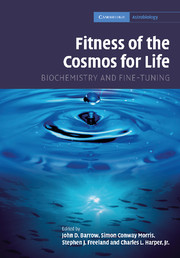Book contents
- Frontmatter
- Contents
- List of contributors
- Foreword: The improbability of life
- Preface
- Acknowledgments
- Part I The fitness of “fitness”: Henderson in context
- Part II The fitness of the cosmic environment
- Part III The fitness of the terrestrial environment
- Part IV The fitness of the chemical environment
- 16 Creating a perspective for comparing
- 17 Fine-tuning and interstellar chemistry
- 18 Framing the question of fine-tuning for intermediary metabolism
- 19 Coarse-tuning in the origin of life?
- 20 Plausible lipid-like peptides: prebiotic molecular self-assembly in water
- 21 Evolution revisited by inorganic chemists
- Index
- References
19 - Coarse-tuning in the origin of life?
Published online by Cambridge University Press: 18 December 2009
- Frontmatter
- Contents
- List of contributors
- Foreword: The improbability of life
- Preface
- Acknowledgments
- Part I The fitness of “fitness”: Henderson in context
- Part II The fitness of the cosmic environment
- Part III The fitness of the terrestrial environment
- Part IV The fitness of the chemical environment
- 16 Creating a perspective for comparing
- 17 Fine-tuning and interstellar chemistry
- 18 Framing the question of fine-tuning for intermediary metabolism
- 19 Coarse-tuning in the origin of life?
- 20 Plausible lipid-like peptides: prebiotic molecular self-assembly in water
- 21 Evolution revisited by inorganic chemists
- Index
- References
Summary
Like others (see for instance Oparin, 1968; Monod, 1970), I too am convinced that the origin of life will be eventually understood in scientific, rational terms. However, I recognize, of course, that so far it remains an unsolved problem, and even an unfathomable one. We scientists are playing with partial explanatory hypotheses and have few hard facts at our disposal. Therefore, we must remain humble in attempting to describe each scenario and be careful to discuss each one's constraints, recognizing where the scenarios may be flexible to synthesis with other hypotheses. Thus, my present discussion explores some areas in which there may indeed be some flexibility in terms of what solutions could potentially lead to living systems – in other words, where some “coarse-tuning” might be tolerable.
Specifically, I address the following series of questions:
Is life necessarily based on carbon?
Must the “bricks of life” have originated by some process closely related to Miller's “spark tube” experiment, or do other possibilities exist?
Is it necessary that any kind of life be associated with water from the start?
Is it necessary for any kind of life to be cellular and for the cells to be bounded in water by membranes?
Are the n-acyl phospholipids of “classical” membranes, or the more recently discovered archaeal lipids, plausible constituents of primitive membranes?
Could early membrane-forming amphiphiles have simply been polyprenyl phosphates, following the “Strasbourg scenario” (Birault et al., 1996)?
Are there automatic consequences of the self-organization of amphiphiles (such as polyprenyl phosphates) in water into membranes, and does this lead to novel properties? Specifically, I consider the available evidence for the following features of membranes:
[…]
- Type
- Chapter
- Information
- Fitness of the Cosmos for LifeBiochemistry and Fine-Tuning, pp. 421 - 439Publisher: Cambridge University PressPrint publication year: 2007



